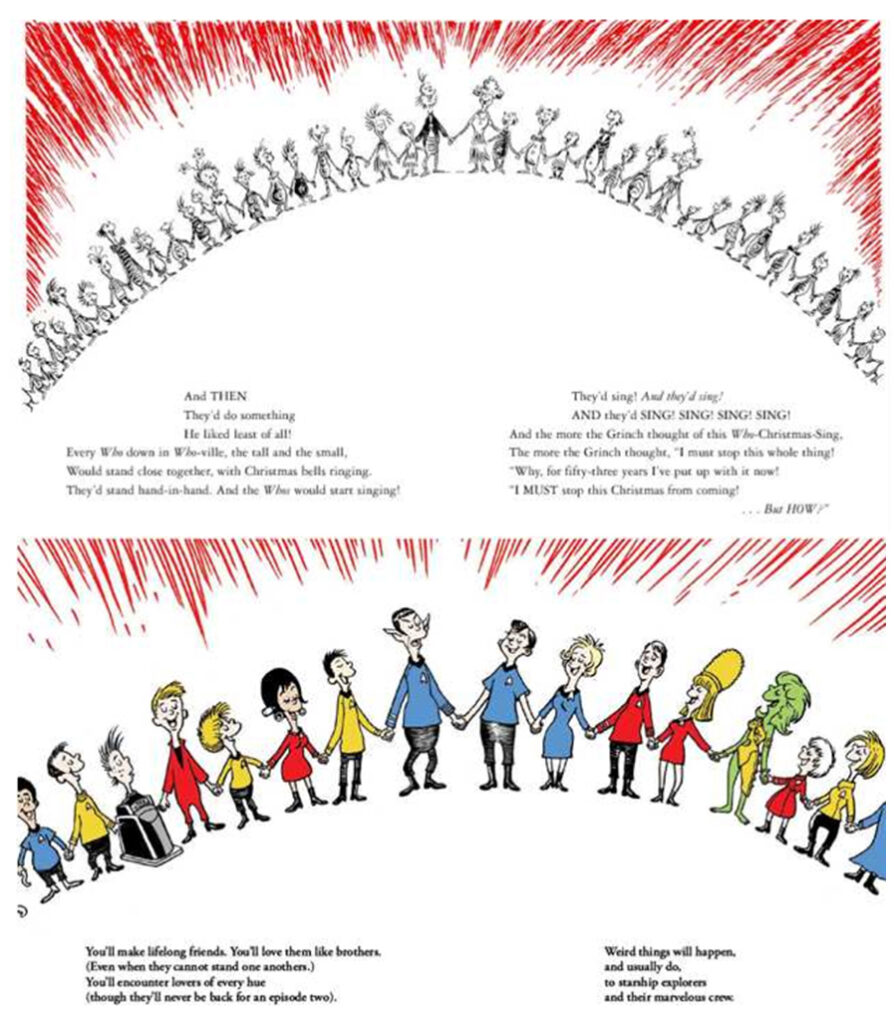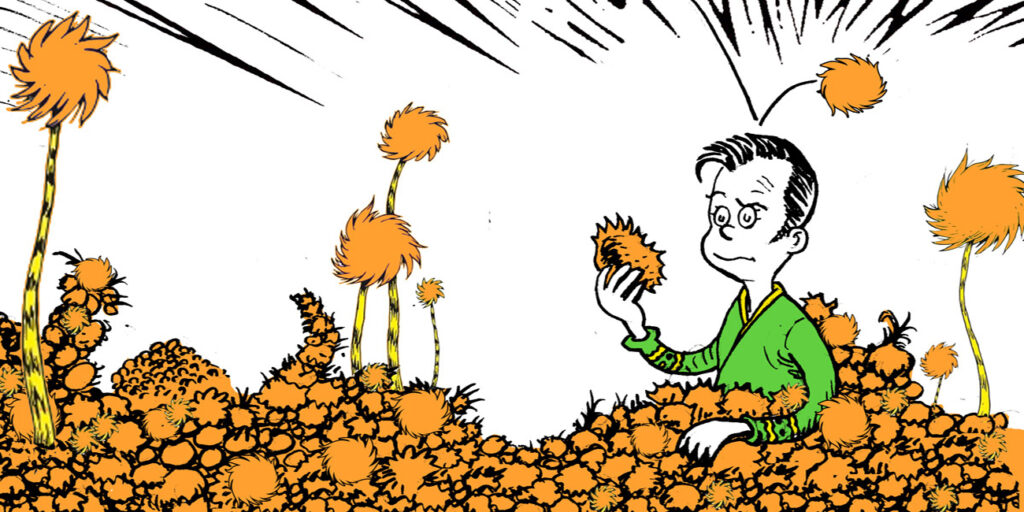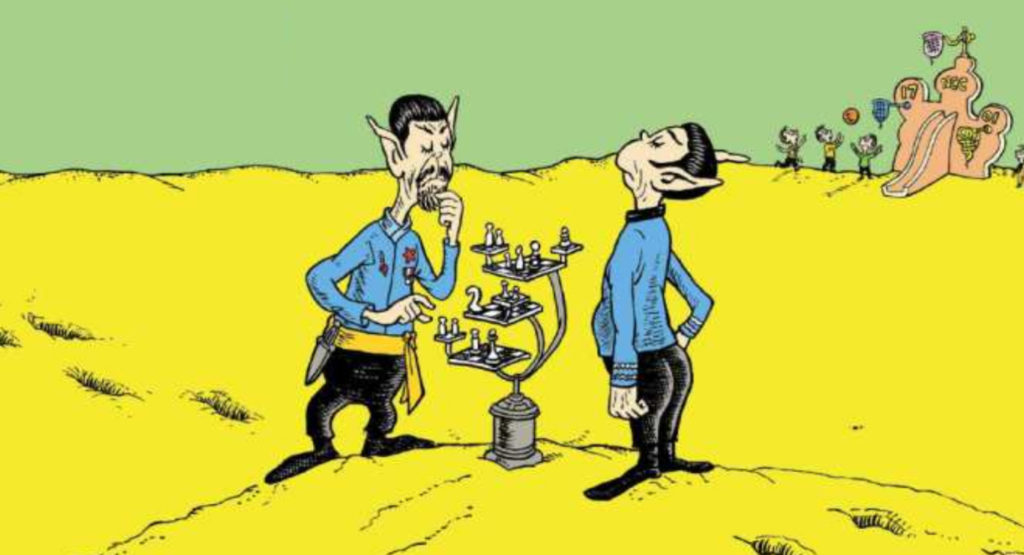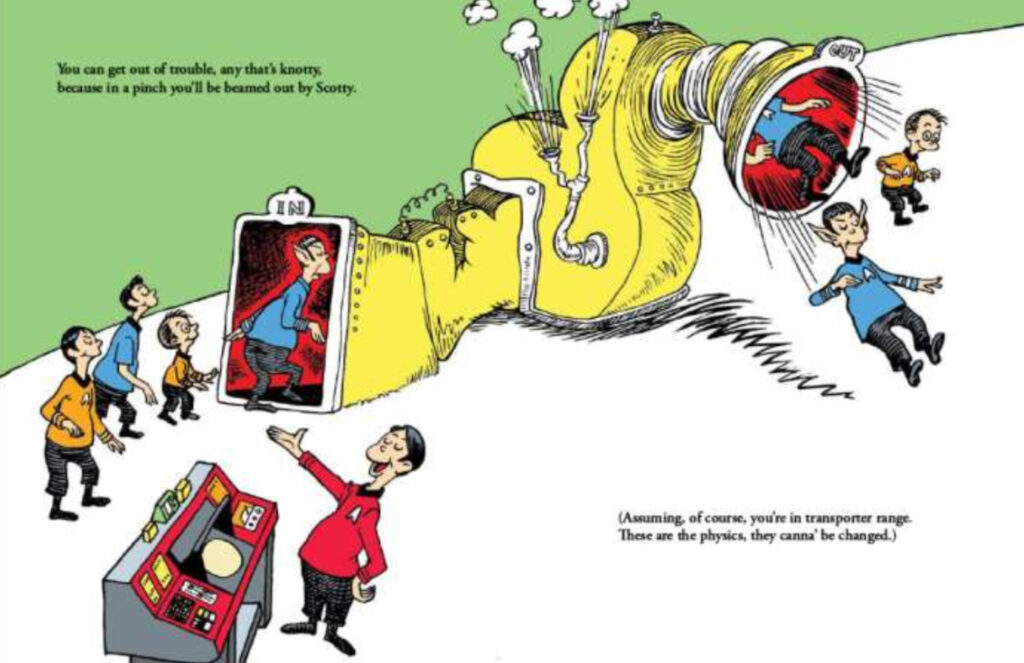Oh, the places you’ll (boldly) go!
For tribbles-creator DAVID GERROLD, artist TY TEMPLETON, ComicMix head-honcho GLENN HAUMAN, and DR. SEUSS ENTERPRISES (DSE), there’s now a chance that one of those places will be the Supreme Court of the United States of America!
You may ask yourself: “Well, how did I get here?” The shortest I can make the answer is this…
- In 2017, DSE sued ComicMix (et al) for copyright infringement for trying to mash-up Star Trek and Dr. Seuss in a crowd-funded book titled Oh, the Places You’ll Boldly Go!
- “Team Mash-up” argued their work was protected under the legal doctrine of fair use.
- Nearly two full years into the lawsuit, Ninth Circuit District Judge Hon. JANIS SAMMARTINO ruled that Boldly was indeed fair use and dismissed the lawsuit before there was even a trial.
- DSE appealed to a three-judge panel of the Ninth Circuit. A year later (2019), they ruled that Boldly was NOT fair use and remanded the revived lawsuit back to Judge Sammartino’s courtroom where fair use could no longer be used as a defense.
- In a motion filed last month, DSE asked the judge to just declare them the winner (again, without going to trial) and award DSE $225,000 in damages.
- Team Mash-up also filed a motion asking for a review of the copyrights for two of Dr. Seuss’s books (that they allegedly copied). Specifically, ComicMix requested a review by the U.S. Registrar of Copyrights because the Sneeches and the Zacks may not have been properly registered and might have fallen into the public domain!
And if you want to do a deeper dive, especially into those last two bullet points, check out this blog.
Okay, a LOT has happened in the last six weeks, and it’s hard to know where to start! When a motion is filed, the other side gets to file an opposition argument, and then the first side gets to reply to that response. So ComicMix has now argued why they think this trial is far from over and they should NOT have to pay $225,000 to DSE. And DSE has argued that ComicMix missed their chance to ask for a copyright review and is now royally screwed.
Oh, and ComicMix just petitioned the United States Supreme Court to review this case! You guys are definitely gonna want me to start there, aren’t ya…?
AIMING HIGH
Okay, before anyone gets too excited that a case involving Star Trek and Dr. Seuss is going straight to the highest court in our land, the odds against that are about 98.5%. That’s because, each year, around 7,000 claimants petition the Supreme Court to hear their cases, and the justices accept only about 100-150 of those cases. So this is hardly a guaranteed “next stop” on the trek for this lawsuit.
However…
The Supreme Court takes up cases if four of the nine justices vote to hear it, and the following three questions are carefully considered by them:
- Could the case have national significance?
- Does this case represent the opportunity to set an important precedent?
- Are different federal circuit courts providing conflicting decisions?
So, does a case about a Star Trek/Dr. Seuss mash-up that was never published or even crowd-funded have “national significance”? Probably not in and of itself. But as Judge Sammartino commented:
This case presents an important question regarding the emerging ‘mash-up’ culture where artists combine two independent works in a new and unique way. … Applying the fair use factors in the manner Plaintiff outlines would almost always preclude a finding of fair use under these circumstances. However, if fair use was not viable in a case such as this, an entire body of highly creative work would be effectively foreclosed.
In other words, the outcome of this case could spell the death of this new mash-up “art form” (if art form it be!) in its infancy! So that could be VERY significant nationally. And as such, this case has the potential—one way or the other—to set an extremely important precedent for American authors and artists…both those who hold copyrights and those who don’t.
So that’s two out of three. What about the last question? As it turns out, this most recent ruling by the Ninth Circuit actually opened the door to an appeal to the Supreme Court by contradicting previous rulings by the Second, Fourth, and Eleventh Circuits (more on that shortly). And when different circuit courts create confusion and uncertainty by disagreeing, the justices of the Supreme Court often feel it is their duty to provide a single interpretation of an otherwise ambiguous law for the benefit of the entire legal community.
JUSTIFYING TO THE JUSTICES
Remember that you can’t appeal a lawsuit just because you didn’t like the outcome and want a “do-over.” You have to find some mistake that was made at the lower court level. In DSE’s case, they felt that Judge Sammartino did not properly apply the law when she ruled that Boldly was fair use, and they citied specific examples, including the fact that ComicMix had not convincingly proved that their mash-up book would not cause DSE significant financial harm. Additionally, they felt that Team Mash-up “slavishly copied” too much from Dr. Seuss’ works and was not so much transformative (which is necessary to be seen as fair use) as it was derivative (which is a copyright no-no). The three-judge appellate panel agreed with DSE and ruled that Boldly is NOT fair use, sending it back to the lower court.
So, according to ComicMix, what legal “mistake” did the three Ninth Circuit judges make in their unanimous reversal decision? And how does that mistake conflict with three previous circuit rulings from other circuits? Get comfortable, folks, because I got some more ‘splainng to do…
The first question that must be asked goes back to the Copyright Act of 1976: is fair use an affirmative defense or a right? In other words, does the defendant have to prove that their work was fair use (in order to excuse it), or does the plaintiff have to prove that the work was NOT fair use and is therefore infringement? Who is responsible for proving what is a big part of most lawsuits.
So one way of looking at this is to initially assume that a work is infringing unless proven otherwise. If so, the defendant needs to say, “Yes, this was infringement, but because it was fair use, it’s okay.” In U.S. law, that’s called an affirmative defense, which means that yes, you admit that you did something you shouldn’t have, but there was an extenuating circumstance that legally excuses it. In this scenario, the majority of the effort in court has to be made by the defendant in proving their work was, in fact, fair use.
The other way of looking at it is from a First Amendment perspective. Wouldn’t fair use be a citizen’s right because Freedom of Speech is a right? Before you start telling me how ridiculous that sounds, consider this. Despite the old trope that you can’t yell “Fire!” in the middle of a crowded theater, the fact is that you actually can. Bill Cosby did it during a comedy routine when he was doing a bit about going to the dentist and getting a cavity drilled. During the comedy routine, Cosby talks about how smoke started coming from his mouth, and he yelled “Fire!” to the dentist. So Bill Cosby yelled “Fire!” in the middle of a crowded theater and was never charged with a crime.
Now, if you yell “Fire!” in the middle of a crowded theater and someone gets hurt in a stampede, that could get you in legal trouble. But what if there really is a fire in the theater? Then you’re simply trying to save lives. So you see, you actually ARE allowed to yell “Fire!” in the middle of a crowded theater under certain circumstances. But depending on the situation and the consequences, it could be illegal to do so. However, if you’re brought in front of a judge and jury, it’s the state that needs to prove you guilty by showing that your action was malicious and caused harm. You’re innocent until proven guilty in this case of free speech, so why not in the case of fair use, as well? Hmmmm…
In their opinion, the three-judge appellate panel pretty much put the pressure on ComicMix to prove that Boldly WAS fair use—essentially requiring them to make an affirmative defense—and the judges found ComicMix’s arguments to be unconvincing. Fair enough, since the Copyright Act of 1976 is kinda vague on who has to prove what. However, one of the four factors of fair use is the “Effect of the use upon the potential market for or value of the copyrighted work.” So if you’re trying to prove in an affirmative defense that your work was fair use, then you (the defendant) need to show, along with the other three factors, that the work does minimal, if any, direct market harm.
The problem with proving no market harm is twofold. First, it’s always problematic to prove a negative about something that hasn’t happened yet. (Try to prove that you will never cheat on your taxes.) But the second issue is even more challenging because proving no market harm requires the plaintiff to share trade secrets with the defendant: licensing opportunities, marketing strategies, sales projections, etc. Assuming the plaintiff refuses to share this confidential information, it places an undue burden on the defendant to prove something based simply on estimates, guesses, and conjecture rather than on quantifiable facts. In their motions, DSE made vague statements about what MIGHT happen were Boldly to be published and sold, but it’s hard to fight hypothetical outcomes without solid facts to dispute them.
Other circuits have ruled in previous copyright cases that the burden of proving financial/market damages must fall onto the plaintiff, not the defendant. The Ninth Circuit panel, however, simply took DSE at their word and assumed market harm without them actually proving it. Instead, they ruled that ComicMix never proved that there would NOT be market harm.
So whose responsibility is it to prove market harm: defendant or plaintiff? Three circuits say plaintiff, the ninth circuit now says defendant. By going to the Supreme Court, the nine justices can clarify. And if they agree with the three previous rulings that it would be the plaintiff’s responsibility to prove market harm, then that high court ruling could result in the reversing (at least temporarily) of the appellate court finding that Boldly was not fair use.
BUT WAIT, THERE’S MORE!
As long as there’s the possibility of going to the Supreme Court anyway, why settle for just getting on base when you can swing for the bleachers and try for a game-winning home run? So ComicMix isn’t stopping with just asking the nine justices to rule on who needs to prove financial damages. After all, that’s just one of the four aspects of fair use, and the Ninth Circuit already ruled on the other three. The Supreme Court could send the case back, and the appellate judges could still conclude that Boldly is not fair use.
So ComicMix is asking the high court to review the case de novo (starting over from the beginning). Their reasoning is that the Ninth Circuit appellate judges used the wrong standard on two of the other main factors, as well as the last one (damages). Remember that Judge Sammartino initially ruled that Boldly WAS fair use, based on three of the four factors favoring the defendant. Maybe she was right and the three judges made the mistake.
Without getting too into the weeds of everything ComicMix is claiming was a mistake, let me just give one notable example. The Ninth Circuit ruled that Boldly had used the “expressive core” of the Dr. Seuss books…but without explaining or analyzing what “expressive core” means. Since damages are awarded per violation, one of the books that ComicMix allegedly “copied” was How the Grinch Stole Christmas! But artist Ty Templeton used only a single drawing from Grinch, changed all of the characters, decreased the number of characters in the drawing, added color, and altered the curve. Take a look…

And even if this single drawing is enough to be considered a “copy,” there are dozens and dozens of drawings in Grinch…and this is just one drawing. So how, then, does one lone drawing from an entire book of drawings constitute the “expressive core” of Grinch?
And keep in mind that, after the Ninth Circuit ruling, DSE is now asking Judge Sammartino to award damages of $75,000 per book that was copied (a total of three for $225,000)! Is this one illustration—part of a book that was never even sold or published—really worth $75,000 in damages?
(Click here to read the full Petition for Writ Of Certiorari to the Supreme Court. It’s fairly short.)
WHY APPEAL NOW WHILE THE CASE IS STILL IN DISTRICT COURT?
That’s an excellent question! After all, the Ninth Circuit just sent the case back DOWN. Why try to send it UP before Judge Sammartino even has a chance to rule on the two recent motions from the plaintiff and the defendant?
The answer is simple: time. ComicMix is appealing the decision of the Ninth Circuit Court of Appeals, which came down last December. There is a 150-day deadline to appeal to the Supreme Court. So basically, Team Mash-up couldn’t wait, lest they forever lose their right to appeal.
So what happens in the meantime? There are still two motions before Judge Sammartino. One could end the case immediately. The other could keep it going for quite a while yet. How will her rulings on those motions affect the appeal to the Supreme Court? And assuming the Supreme Court takes up this case (with their earliest possible decision coming after their next session in another year), how might their ruling affect what happens with DSE and ComicMix in Judge Sammartino’s courtroom?
Oh, man, I am so going to need another blog to answer all of those questions! Come back tomorrow, my friends…






My brain hurts…
You didn’t have to write it, dude! 🙂
And there’s 2,900 more words where that came from, Ronnie. I had to read seven different long legal filings and figure out how to explain them…all while still making it casual and funny enough to not put everyone to sleep.
The fact is that this is a VERY complex case, and I write these blogs for people who want to understand what is happening rather than simply keep tabs on the latest updates. For the latter, it’s fine to just skim. But if you don’t want to be completely surprised by what happens next, you’ve either got to read all those ridiculously long and dry legal filings or else get your brain through these super-long blog posts. Up to you…but I’m here either way. 🙂
And I appreciate you doing it, Jonathan, believe me.
Thanks, Ronnie.
I suspect my lawyer husband and son would pay more attention to their CLE (continuing legal education) online workshops if they referenced Star Trek!
Have them read over my analysis and tell me how I did! 🙂
Thank you for the excellent summary.
Unfortunately, given the current makeup of the Supreme Court, even if four Justices agree to take the case, it seems highly unlikely a majority of the Court would take the side of the little guy here.
It’s hard to tell on this one. The three appellate judges on the Ninth Circuit who heard the appeal were each appointed by liberal presidents and ruled unanimously against ComicMix. So there’s no guarantee that liberals or conservatives will necessarily come down in one direction or the other.
Might want to edit the paragraph beginning “Remember, you can’t just appeal…” because you first claim the judge did not rule for fair use, then later say the Appeals Court was the one who said it wasn’t. Also, you left out an “L” in “boldly”.
Good catches, Reece. I re-read that blog three times, fixing all sorts of other things, but missed those two items. They’re fix now…thanks!
<rules lawyer>
1 – “A year later (2019), they ruled ruled that Boldly” – Double use of “ruled” ruled invalid.
2 – “Does the case could have national significance?” – Invalid sentence structure, namely “could” should be the first word instead of “does”.
</rules lawyer>
<fan boy>
SUPREME COURT!!!!! ARE YOU KIDDING ME!!!!!
This is going to be Awesome!
</fan boy>
Thank you for your concise and entertaining translations.
Ack, more typos!
I’m dreading to see how many you folks catch on my follow-up blog entry!!!
I almost but not quite hate to write this, but I started wondering how the current justices might rule based on how they’ve ruled in similar cases – the fine art of informed guessing to be sure.
I also wonder how scotusblog might report this blog posting and the next one and the story in general?
For those that don’t know: https://www.scotusblog.com/
I’m guessing that SCOTUSblog would do an infinitely better job than I did, but I doubt they’d have as many fun graphics! 🙂
As for the SCOTUS ruling based on prior rulings, it’s hard to say. I’m not sure if Mash-ups have ever made it this high before. But it’s a pretty simple question…at least the first one: which party is responsible for proving future market harm, the defendant or the plaintiff? Now, if the high court agrees to a review of the entire case de novo, then it’s anyone’s guess! How many closet Trekkies are there on the bench? I suspect Sonya Sotomayor and Elena Kagan to be pretty likely…and possibly Neil Gorsuch. But Kavanaugh’s always the wild card! He might fancy himself a Captain Kirk with all the women and the drinking, so you never know. And Roberts is a total Spock. Clarence Thomas, however, has probably never watched a minute of sci-fi in his life. 🙂
Eeeeeee, this gets even more exciting with every new detail! Boldly going beyond the furthest reaches of the Axanar lawsuit to pay a visit to Q (as the high court judge)!
Btw I have noticed two errors in this post:
+ “Does the case could have national significance?” <= grammar.
"In DSE’s case, they felt that Judge Sammartino did not properly apply the law when she ruled that Boldy was NOT fair use" <= but she did rule it fair use…
Yep, others found those same typos (see above), and they’ve been corrected.
It’s interesting to wonder if the Axanar lawsuit might have eventually made it to the high court, as well. The question of whether fair use is an affirmative defense or a right is an intriguing one. If it’s an affirmative defense, then cana judge or judges rightfully determine fair use as a matter of law rather than as a matter of fact? In other words, can a judge come in early and rule on fair use pre-trial (as a matter of law), or should that determination be left to a jury to consider as a finding of fact? That’s what most likely would have been in the Axanar appeal had things gotten that far. And indeed, that judge’s December 2016 ruling that Axanar was NOT fair use is what quickly led to the settlement, as he opened the door to an appeal by the defense, and CBS didn’t want this annoying and PR-damaging case to continue on for another year or three (especially against a defendant getting free legal services)! 🙂
“the Axanar lawsuit might have eventually made it to the high court” <= Indeed! I remember you saying so in your blog posts and it was the first thing I thought of when I saw the title in my inbox. 🙂
Then when reading the blog post it got me wondering "What if this Seussian legal adventure had occurred before the Axanar lawsuit with Fair Use getting ruled as a right that put the onus on CBS to prove lost revenue? What might have happened differently"
It’s hard to say because this case is far from over (I think!). The outcome–whatever it be–could have spelled sweet victory for Axanar or bitter defeat. Y’see, like mash-ups, fan films are a pretty recent development…especially ones of the quality level of Prelude. So there really isn’t much case law yet to deal with such things.